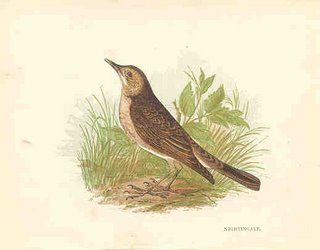 Now that it’s finally warmed up in upstate N.Y., I’m enjoying birdsong outside my window again. It reminds me of the first spring after my husband and I were sent on assignment to the U.K., when I realized that the birdsongs there were quite different. Later that spring, I heard a real live nightingale for the first time. Nothing like it.
Now that it’s finally warmed up in upstate N.Y., I’m enjoying birdsong outside my window again. It reminds me of the first spring after my husband and I were sent on assignment to the U.K., when I realized that the birdsongs there were quite different. Later that spring, I heard a real live nightingale for the first time. Nothing like it.
Anyway, I thought I’d share some of my favorite British birds.
European Goldfinch (above) live in the wild but have also been domesticated for a long time, as evidenced in the painting of Madonna of the Goldfinch by Giovanni Battista Tiepolo (1696-1770) (right).  According to a Myra, a helpful lady with a website on finches, The Finch Niche, the Euro Goldfinch is one of the tamer and more interactive species. It is possible to train them to sit on peoples’ fingers or heads (unlike most finches, which are more, um, flighty) and when whistled to they will whistle back. So I thought they’d make a nice pet for the children in LADY DEARING’S MASQUERADE.
According to a Myra, a helpful lady with a website on finches, The Finch Niche, the Euro Goldfinch is one of the tamer and more interactive species. It is possible to train them to sit on peoples’ fingers or heads (unlike most finches, which are more, um, flighty) and when whistled to they will whistle back. So I thought they’d make a nice pet for the children in LADY DEARING’S MASQUERADE.
Click here to hear a recording of a goldfinch’s song.
 Another fave is the nightingale (left). A most romantic bird—just imagine it serenading your moonlit liaison with a dashing Regency hero in a secluded bower. It’s not much to look at, actually, but check out this recording of its song. (Just try to imagine it without the street noises.)
Another fave is the nightingale (left). A most romantic bird—just imagine it serenading your moonlit liaison with a dashing Regency hero in a secluded bower. It’s not much to look at, actually, but check out this recording of its song. (Just try to imagine it without the street noises.)
For more birdsongs, check out Northamptonshire Wildlife’s Sound Gallery. They’ve got just about everything including the Common Chiffchaff to the Great Tit (I’m not making these up, honest!)
The images of the goldfinch and nightingale are prints (c.1870) available at www.printspast.com. More great bird images from Morris’s British Birds 1891 at www.birdcheck.co.uk.
Any favorite birds, British or otherwise? Do you enjoy descriptions of nature in a romance, or do they leave you cold?
Elena
www.elenagreene.com
LADY DEARING’S MASQUERADE, an RT Reviewers’ Choice Award finalist

Thanks for sharing this info and the lovely pictures, Elena. Like you, I am so happy that Spring seems to have finally Sprung here in NY.
I like descriptions of nature; sure, it can be overplayed, as in ‘a dark and stormy night,’ but setting the scene is so important, and hard to do. I like reading authors who do it well (unlike me, actually).
I am hugely ignorant of the natural world. The limit of my knowledge is that birds are those things that cats want to eat. That aren’t mice. Or fish, or ice cream, or my dinner…. Birds are those flying things that cats want to eat. That aren’t bugs.
Squirrels are the things that ruin my plants and run across the roof very loudly.
Skunks don’t really exist. There’s some guy out there with “skunk spray” and every now and then he sprays the freeway or your dog, so people continue to believe that skunks are real.
Cara
My favorite bird is the Cardinal, our Virginia State bird! I love to see them in the yard.
And, Cara, I know skunks exist because I was bit by one!
When I was a kid. The de-scented pet of our next door neighbors.
Diane (who blogs about half dresses men and isn’t nearly as classy as Elena!)
Cara, skunks do exist. My brothers and I narrowly avoided quite a few of them while delivering newspapers early in the morning. Sometimes we’d have to skip a house and come back later, hoping the coast would be clear and no cute little scent-bomb was hiding in the shrubs.
Diane, I’m not sure how to take that “classy” remark! I hope you are not implying I am too high-minded to admire other forms of nature. Especially when they emerge dripping from a plunge in the pond on their estates. Or when they stride across misty meadows with their shirts open. Or…oh well, I’d better quit before I’ve shattered all your delusions!
Elena 🙂
My favorite birds are the different and unusual ones that obviously are lost if they fly and land around here. LOL We’re not a big city, but we’re a city, so we have pigeons. But once in a blue moon, we’ll see something different than that, and at that moment they are my favorite. 🙂
Lois
Elena,
You really are classy!!!!! And broadminded enough to love nature in all its glory.
Like Lois’s photo accompanying her message. Way to go, Lois!
Diane